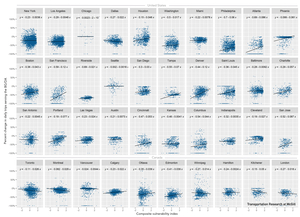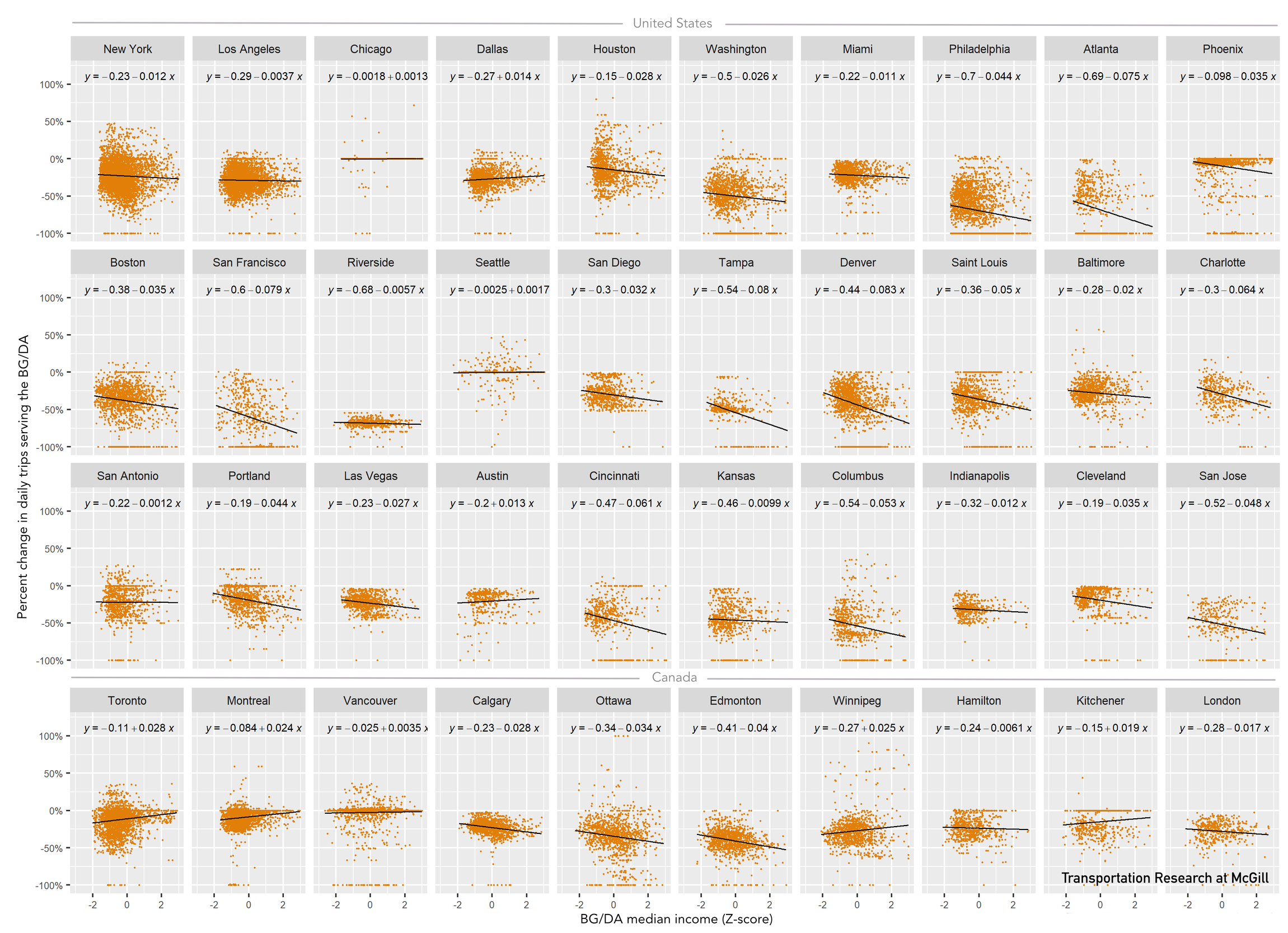Research Question and Data
Public transport ridership in North American Cities declined dramatically by the end of March 2020 as governments applied confinement measures in response to COVID-19 pandemic (Hart 2020; Vijaya 2020). In an industry that depends heavily on fare-box recovery to pay for operations and sometimes infrastructure loans (Verbich, Badami, and El-Geneidy 2017), transport agencies faced major financial strains, even as the pandemic magnified their role as a critical public service, ferrying essential, often low-income, workers with limited alternatives to their jobs (Deng, Morissette, and Messacar 2020). Public transport agencies also faced major operating difficulties due to absenteeism among operators (Hamilton Spectator 2020) and enhanced cleaning protocols. These financial and operating challenges have forced public transport agencies to reorganize their services, reducing frequency in some areas while bolstering it in others serving hospitals and essential services. This paper addresses the following research question:
Are the service adjustments imposed by public transport agencies in North American cities disproportionately affecting low-income or otherwise vulnerable areas?
Methods and Data
We measure service adjustments—the percent change in the number of unique trips serving a given area during a weekday—at the census Block Group (BG) (for top 30 US cities by population) or Dissemination Area (DA) (for top 10 Canadian cities by population) levels. For each city, we compare General Transit Feed Specification (GTFS) data for the primary public transport provider before and after the beginning of Covid-related shutdowns: First in February 2020 and then in April 2020 or May 2020, depending on feed availability (working GTFS feeds were not available for Detroit, MI, Minneapolis, MN, and Pittsburgh, PA, and we excluded them from this analysis). Table 1 lists the studied cities, main public transport agency, and population of the metropolitan region where the city is located.
To calculate percentage changes in service frequency, we spatially intersected GTFS stop-level data from both time periods with the BGs or DAs, eliminating outliers in the top 1-percentile of service increases, which appeared to reflect minor re-routes that shifted service to immediately adjacent areas where there was previously none rather than COVID-related adjustments. These two numbers were then subtracted from each other and divided by the number of unique daily trips before COVID-19. We then plotted the percentage change in service at the BG and DA level against two measures of vulnerability at the metropolitan region level: normalized median income (Z-score) and a composite vulnerability index based on normalized rates of areal sociodemographic characteristics. Income and demographic data were obtained from Statistics Canada and the U.S. Census Bureau. The vulnerability index for BGs in US cities is derived from the sum of Z-scores of: median household income, percentage of non-white residents, and proportion of population with no bachelor’s degree, all divided by three. For Canadian cities, the DA-level vulnerability index integrates median household income, percentage of labor force that is unemployed, percentage of population that has immigrated within the last 5 years, and percentage of households that spend more than 30% of income on housing rent, divided by four (Foth, Manaugh, & El-Geneidy, 2013). We did not include the proportion of visible minorities in the Canadian index. While it is beyond debate that racialized and visible minorities face both overt and systemic racism in Canada, residential racial segregation in most Canadian cities generally follows different patterns than in the United States, reducing its utility as a metric of geographically distributed socioeconomic vulnerability (Myles and Hou 2003). There are at least two important caveats regarding this approach to assessing vulnerability: First, although BGs and DAs are designed to contain roughly comparable population sizes, the number of people in each can vary by location. This means that service reductions in one DA may affect a larger or smaller number of people than identical cuts in another. Relatedly, the use of rate-based, z-scores accounts for the distribution of certain sociodemographic characteristics among the BGs or DAs and does not necessarily reflect the absolute number of vulnerable individuals present within the affected area. Future research may also include other metrics for vulnerability, such as reduced mobility, which will require further knowledge of changes in paratransit services in addition to changes to regular service and is out of the focus of the study. The use of percentage of service adjustments, income Z-score, and a normalized vulnerability index enables us to directly compare the changes in the public transport services across cities.
Findings
Figure 1 shows the percentage change in the number of unique trips in each census area on the Y-axis and the Z-score for income groups on the X-axis. Lower-income areas are represented in the negative side of the chart and higher income in the positive side as Z-score is used for normalization purpose, with Canadian Cities listed in the bottom.
Almost all transit agencies applied major service adjustments, albeit at different rates. Chicago’s CTA appears to have intentionally avoided making any major service reductions in response to Covid, asserting that public transit represented an essential public service particularly for workers and first responders (Chicago Transit Authority 2020). Seattle applied minor service adjustments and cuts with little impact on low income areas. Cities like Miami and Riverside implemented only service cuts, impacting all income groups almost at the same level. New York and Houston applied substantial changes in the service across all income groups including both additions and cutting of services. Toronto and Montreal applied both service cuts and additions that impacted low income areas in a disproportional way.
Figure 2 shows the percentage change in service adjustment on the Y-axis and the vulnerability index on the X-axis (US and Canada (bottom row) use different components for the index), please note that higher levels of vulnerability are represented in the positive side of the chart and affluent or least vulnerable is on the negative side of the chart.
A steep upward trend line in Figure 2 (San Francisco and Portland) indicates more sensitivity in the service adjustments toward vulnerable groups with less cuts and more additions in the services passing through BG or DA with higher concentration of vulnerable groups. While a flat trend line (New York, Los Angeles, and Miami) indicate that service cuts and additions were done almost equally across the different BG or DA. While a downward trend (Montreal and Toronto) indicates that service cuts did happen more in BG and DA with higher concentration of vulnerable groups. It is clear that some agencies accounted for vertical equity (providing more to those who are in need for the service) in their service adjustments while others concentrated more on horizontal equity (providing adjustments equally to all groups). Other measures of equity can be used to evaluate the decisions made by various agencies, yet in this research we concentrated on vertical and horizontal equity. Future research can apply the changes in levels of accessibility to essential services, yet it will require having a list of essential services available in each region at the time of confinement, which was not available for us at the time of conducting this research.
Disclaimer
An earlier version of the manuscript contained two errors. Thanks to Chris Cherry and Anson Stewart for pointing them out. It is important to note that this study reports readily available data posted online by the different public transport agencies, and any errors is a reflection of the posted data.
Acknowledgments
We would like to thank Prof. David Levinson for the efficient handling of the reviews, we also would like to thank the two anonymous reviewers for their detailed feedback on the earlier version of the manuscript. This research was funded by the Natural Sciences Research Council of Canada (NSERC) Discovery Grant (NSERC RGPIN-2018-04501) and the Social Sciences and Humanities research Council of Canada (SSHRC) Access Across Canada project (SSHRC 435-2017-0328).




